The Gorilla Families of Volcanoes National Park
Written by
Ker & Downey® Africa
An encounter with the mountain gorilla families in Rwanda is an aspiration for travelers around the world.
The gorillas of the Volcanoes National Park that once evoked fear in humans, are now seen as gentle giants of the forest. These enigmatic primates draw huge crowds each year to witness their extraordinary anthropomorphic behaviour. And this is all due to the groundbreaking research of iconic primatologist, Dian Fossey.
Where to see the gorilla families in Rwanda
The Volcanoes National Park in Rwanda is the oldest national park in Africa. It is home to more than half of the world’s remaining mountain gorillas. The park was named after the chain of dormant volcanoes that make up the Virunga Massif. It was also the base for Dian Fossey to conduct over 14 years of research. And subsequently set the scene for Gorillas in the Mist – the film that portrayed Fossey’s life on the big screen.
It is considered to be the best gorilla trekking destination in the world.
Today, The Volcanoes National Park in Rwanda has around 380 mountain gorillas and 10 gorilla families which are available for gorilla trekking.
About Dian Fossey
Dr. Fossey is widely credited for contributing to huge scientific breakthroughs when studying the gorillas in Rwanda. It was Fossey that would change their public image forever. She lived alongside the gorillas for over a decade and revealed their complex personalities and rich social lives. She showed the world how these magnificent primates demonstrated behaviour that was very much like our own.
Perhaps one of Fossey’s greatest discoveries when living with the group of mountain gorillas she observed was that they have families. And, like humans, share strong relationships with one another, particularly offspring. She also witnessed the deep mourning that took place over the loss of family members.
This loss was caused primarily by poaching – a subject that became very close to her heart. The Digit Fund, as well as the Karisoke Research Centre keep Fossey’s legacy alive in the lush forests she once called home. And her work has inspired a whole new generation of Africa conservationists, giving hope to the world’s remaining mountain gorillas.
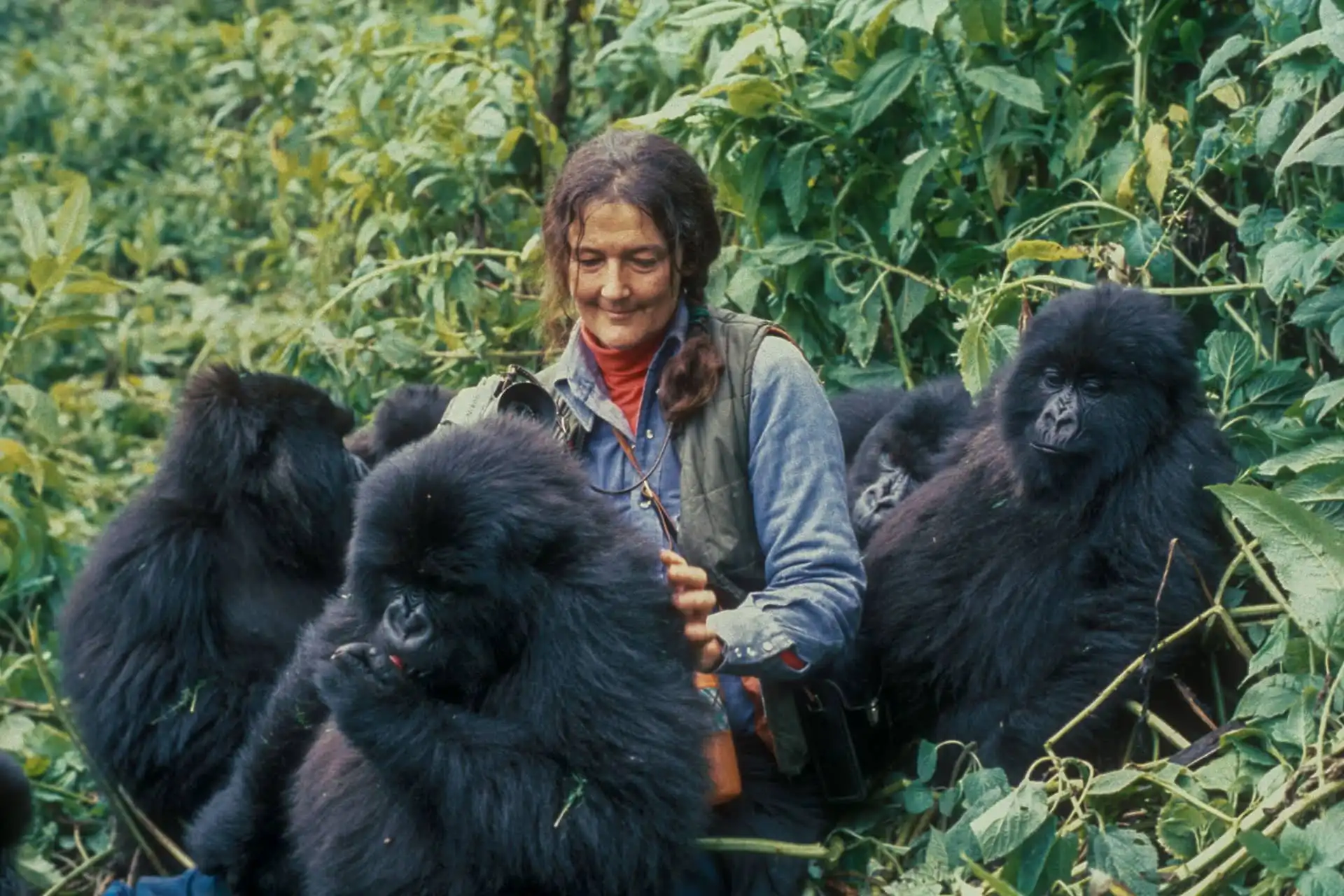
Dian Fossey interacting with gorillas in the Volcanoes National Park. Photo Credit | National Geographic
Meet the 10 habituated gorilla families in Rwanda that call the Volcanoes National Park home:
Susa Group (Susa A)
The Susa group is the most well-known family of mountain gorillas in Rwanda and was studied by Fossey the longest. This fascinating group originally comprised 42 individuals, but after a major internal conflict in 2008, 15 of the members split from the original group. The family is named after the Susa River, which runs through their territory on the lower slopes of Mount Karisimbi. There are now 33 members in total, including two big silverbacks.
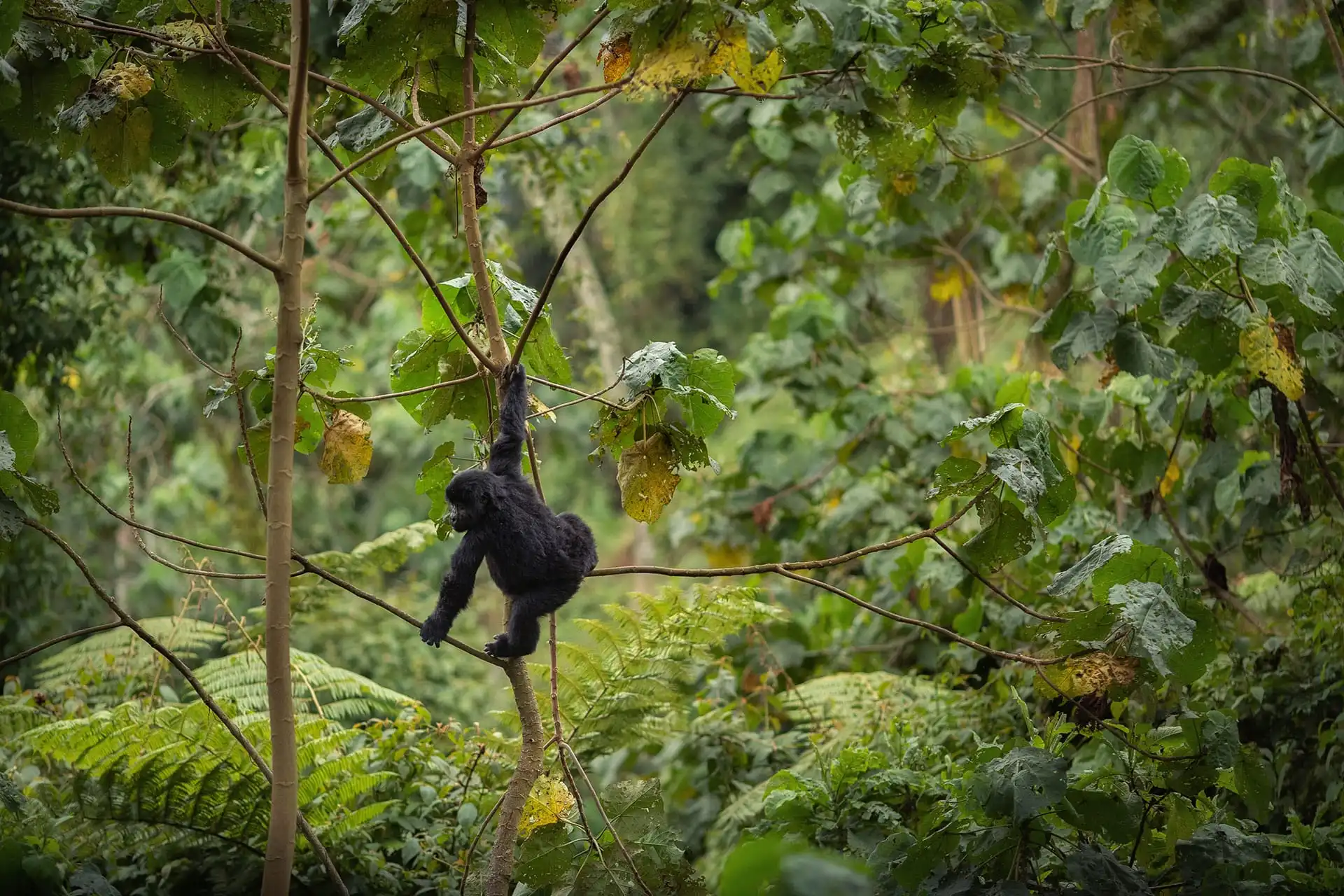
A young mountain gorilla
Karisimbi Group (Susa B)
The Karisimbi family, or Susa B, are the group of mountain gorillas which split from Susa A in 2008. There are now 16 members, including the two original silverbacks. When the group split, the rogue gorillas made their way higher up the slopes of Mount Karisimbi, making their new home at an altitude of 4507m. Those wanting to track this notorious family will have to endure a seriously arduous hike up steep slopes and tough, rocky terrain.
Titus Gorilla Family in Rwanda
The late silverback gorilla, Titus, was born during Dian Fossey’s time in Volcanoes National Park. He was orphaned when he was just four years old after his entire family was killed by poachers. Titus grew up to be a strong leader, while always remaining calm and kind.
Titus was a preeminent figure who eventually succumbed to old age in September 2009. His passing marked the end of four decades of defying the odds and revealing more to primatologists and naturalists than any other gorilla. The Titus group is named after this gentle giant, and can be found occupying territory around Mount Bisoke and the Karisimbi slopes.
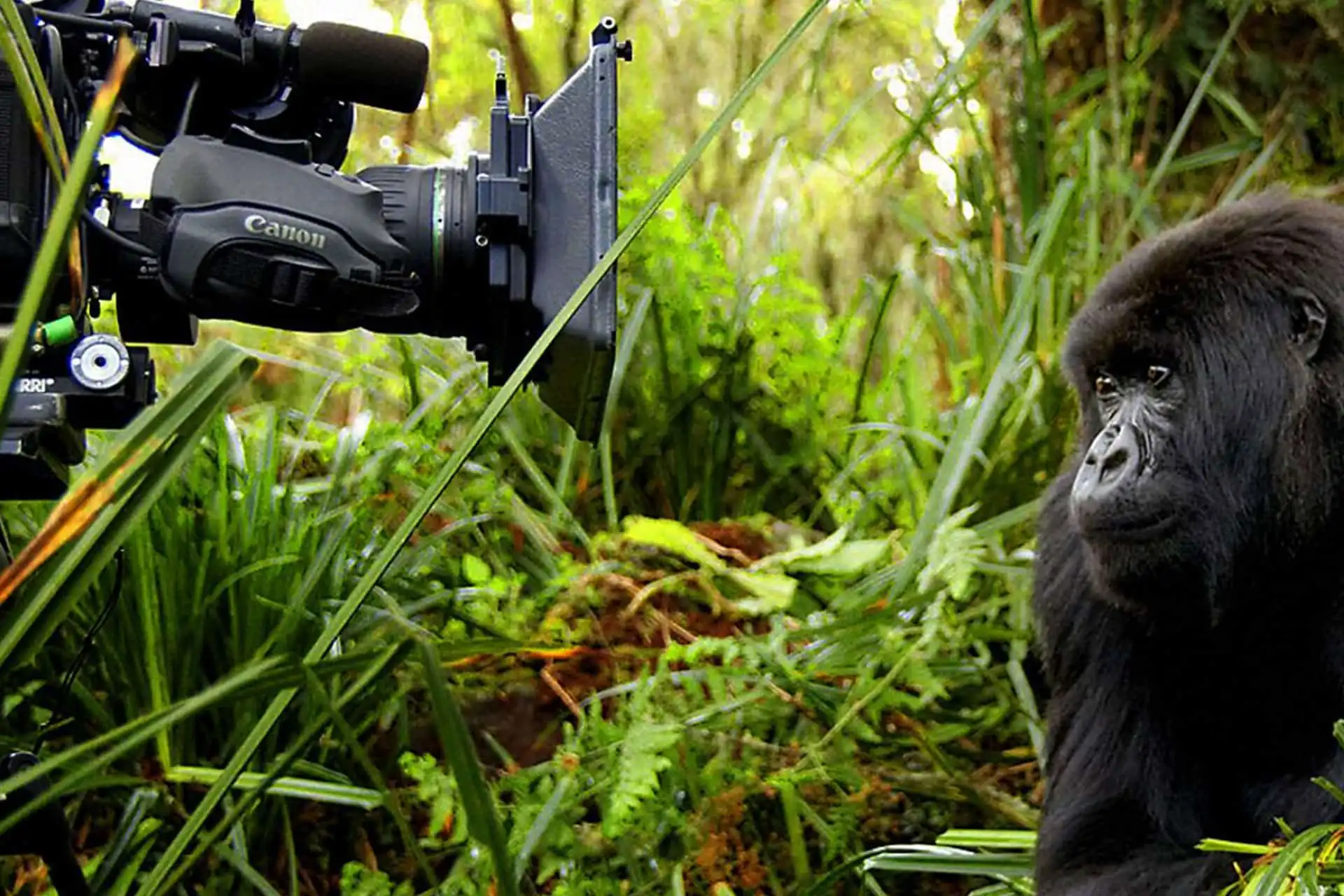
A behind the scenes shot of Titus during a 2008 BBC documentary about one of the most powerful silverbacks in Rwanda’s Virunga Mountains. Photo Credit | BBC
Bwenge Group
Bwenge is a local word that means ‘wisdom’ in Kinyarwanda. The Bwenge group of gorillas is arguably Rwanda’s most popular group. The family of gorillas was the group featured in the movie Gorillas in the Mist – the 1998 blockbuster about Fossey and her work in the park. The group has 11 members, including one silverback, and occupies the slopes of the Karisoke volcano.
Ugenda Group
Ugenda is another local word, meaning ‘mobile’ or ‘on the move’. This is a fitting name for the troupe of 11 mountain gorillas, notorious for being the most difficult to track down. Because the group never seems to settle for any particular length of time, their whereabouts (thought to be mostly around Mount Bisoke) are mostly unknown.
Kwitonda Group
Kwitonda means ‘humble one’ and got its name from a particularly impressionable dominant silverback of the group. The large group comprises 23 members, including four silverbacks and migrated from their original home in the Democratic Republic of Congo. Because of this, they mostly inhabit the slopes of Mount Muhabura – a difficult trek for very serious hikers.
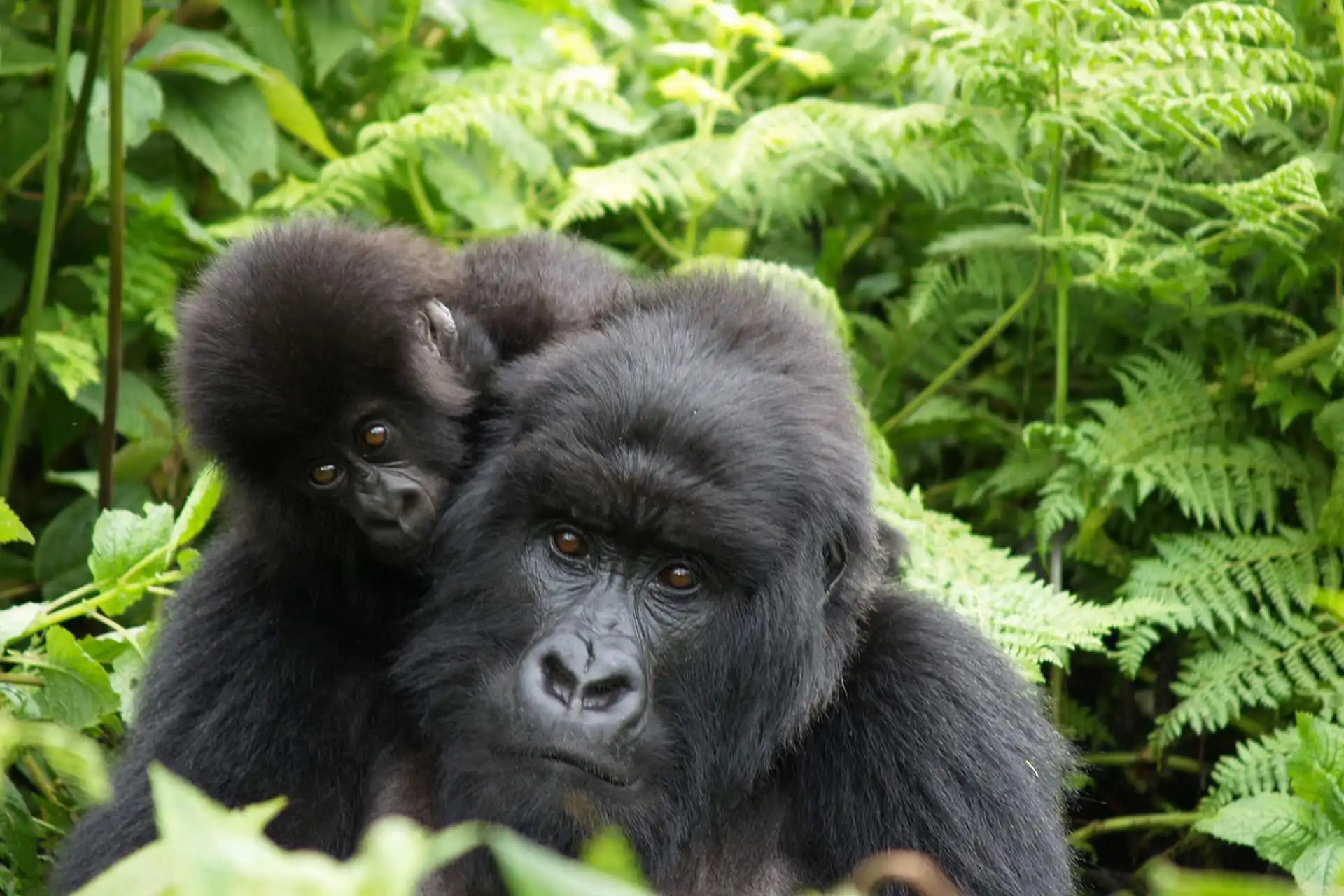
An adult member of the Kwitonda family carries a baby. Photo Credit | Singita Kwitonda Lodge.
Agashya Group
This was the first gorilla group to become habituated and comprises 27 members with one silverback. Agashya, meaning ‘news’, is the name of the dominant silverback who took over the initial group by overthrowing its then leader, Nyakarima. The group move alongside the Sabyinyo family, mostly around Mount Sabinyo and the Gahinga slopes. Agashya is a commanding leader who moves his family higher into the mountains as soon as he senses danger.
Sabyinyo Group
The Sabyinyo inhabit the gentle slopes between Mount Sabinyo and Mount Gahinga and are considered the easiest of all the gorilla families to track.
The group of 13 is governed by Guhonda – the largest silverback in Volcanoes National Park, weighing in at around 460 pounds (220 kilograms).
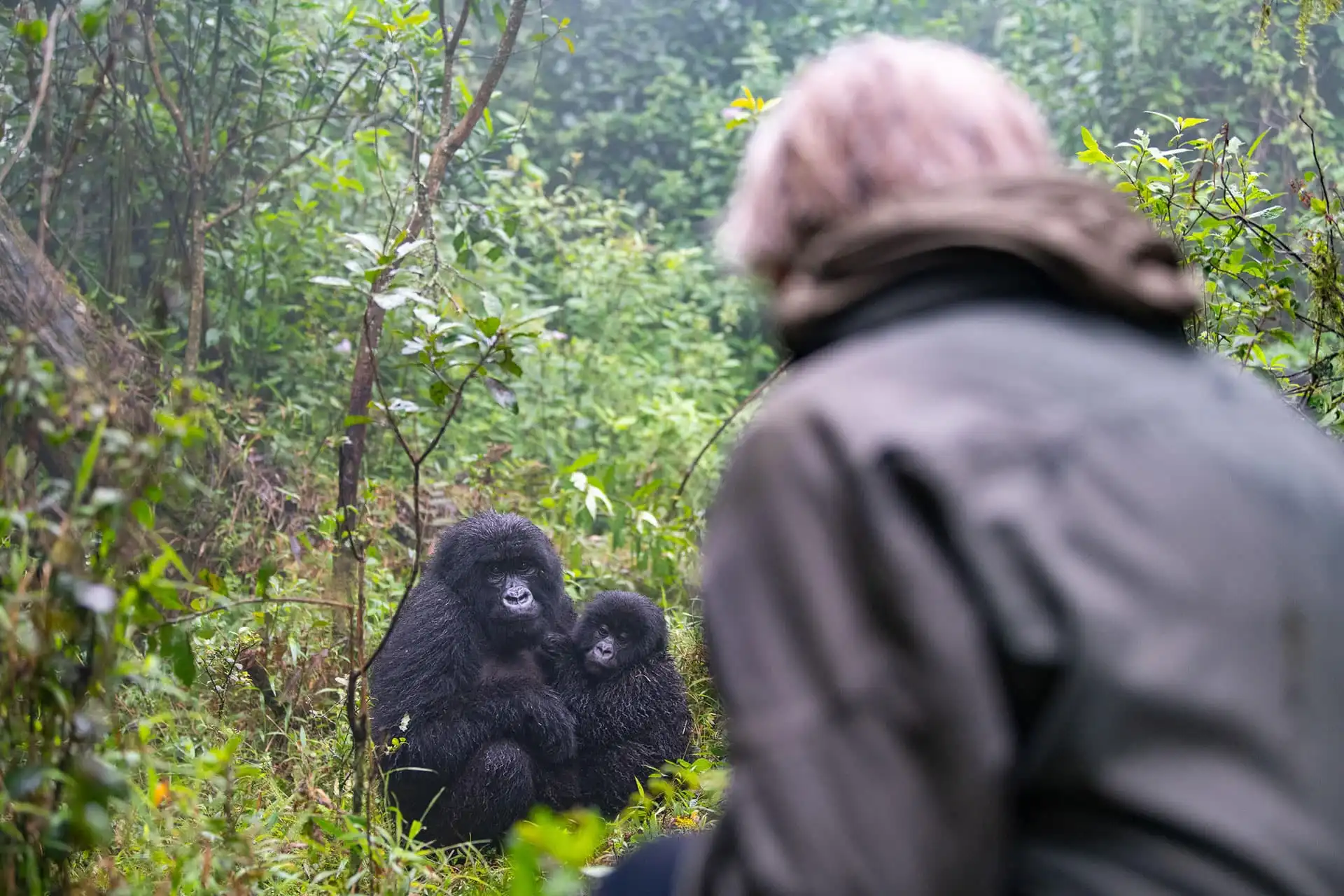
A close encounter with some members of the Sabyinyo group during a gorilla trekking expedition at Sabyinyo Silverback Lodge in Rwanda. Photo Credit | Sabyinyo Silverback Lodge
Hirwa Group
The Hirwa family was formed in 2006 and comprises 16 members, including one big silverback. The word Hirwa, meaning ‘lucky one’ was derived from the group being formed out of luck, with some members from the Sabyinyo group joining others from the Agashya family. The group is well-known for its twins, born in 2011. They are mostly found occupying the foothills of Mount Sabinyo and Mount Gahinga.
Umubano Gorilla Family in Rwanda
Though the word Umubano means ‘live together’, this group of gorillas was formed by members of the Amahoro family breaking apart. The original leader of the Amahoro family, Ubumwe, was forever challenged by another big silverback named Charles who eventually broke away from the group altogether taking 13 members with him.
Amahoro Group
Despite the conflict that led to the formation of the Umubano group, the Amahoro group are considered the most peaceful of the Volcanoes NP gorillas. The 18 members, including two silverbacks, live on the slops of Mount Bisoke and embody the meaning of their family name: ‘peaceful.’
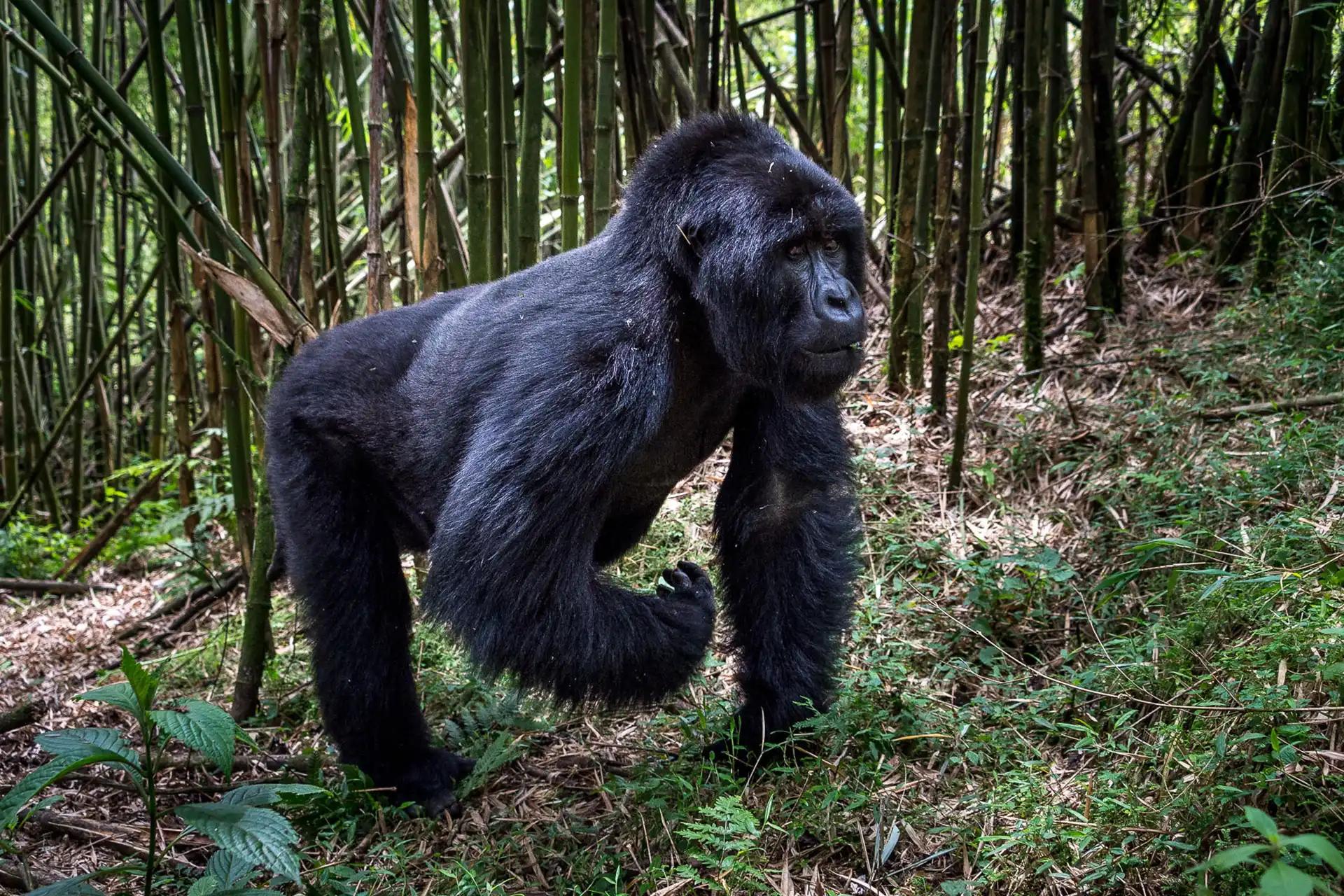
A large silverback gorilla. Photo Credit | Bisate Lodge
Each time you purchase a gorilla permit, you contribute directly to gorilla conservation. This includes the management of the parks, the monitoring of gorillas and the salaries of rangers. Get in touch with our LuxVenture® Designers to curate a gorilla trekking experience today, and witness these extraordinary creatures like never before.
Curated Packages
Signature journeys across Africa
Our expert team crafts journeys that transcend luxury. Each itinerary is shaped by the spirit of the land and the wisdom of its people — opening doors to experiences few can imagine, and even fewer will ever access.
June-August
|
12 DAYS
Rovos Rail and Zambezi River Escape
From
per person
All Year Round
|
11 DAYS
Cape Town Safari & Whale Coast Adventure
From
per person
June - Sept
|
8 DAYS
Rivers & Rainforests: A Ugandan Safari
From
per person
All year round
|
9 DAYS
9-day Victoria Falls to Botswana Luxury Safari
From
per person
All Year Round
|
12 DAYS
Tanzania & Zanzibar Honeymoon Safari
From
per person
June - Sept
|
15 DAYS
Gorillas & Big Five Safari Adventure
From
per person
May-October
|
10 DAYS
South Luangwa Walking Safari
From
per person
All Year Round
|
14 DAYS
Southern Africa’s Finest: SA, Victoria Falls & Botswana
From
per person
All Year Round
|
17 DAYS
Southern Africa: Framed and Untamed
From
per person
All Year Round
|
8 DAYS
Best of Egypt LuxVenture®
From
per person
March-December
|
10 DAYS
Luxury Private Safari in Zambia
From
per person
All Year Round
|
6 DAYS
Luxury Morocco Vacation
From
per person
June-October
|
7 DAYS
African Wild Dog Safari
From
per person
All Year Round
|
9 DAYS
Botswana Okavango Honeymoon LuxVenture®
From
per person
All Year Round
|
9 DAYS
Luxury Safari in Kruger National Park & Cape Town
From
per person
All Year Round
|
7 DAYS
Luxury Gorilla Trekking Safari in Rwanda
From
per person
All Year Round
|
16 DAYS
Ultimate East Africa Safari
From
per person
All Year Round
|
12 DAYS
South Africa Art, Wine & Wilderness Safari
From
per person
All Year Round
|
9 DAYS
‘Out of Africa’ Safari in Kenya
From
per person
All Year Round
|
10 DAYS
Cairo + Luxury Nile Cruise
From
per person
All Year Round
|
Day Trip to Antarctica LuxVenture®
From
per person
All Year Round
|
14 DAYS
Luxury South Africa and Mozambique Honeymoon
From
per person
May to October
|
8 DAYS
Mad Max Safari Adventure
From
per person
All Year Round
|
17 DAYS
Luxury Mauritius & South Africa Experience
From
per person
All Year Round
|
10 DAYS
Botswana & Victoria Falls Adventure
From
per person
All year round
|
9 DAYS
Beaches of Seychelles Vacation
From
per person
All year round
|
12 DAYS
Luxury Family Safari: South Africa & Victoria Falls
From
per person
May-October
|
8 DAYS
Luxury Treehouse Safari to Botswana LuxVenture®
From
per person
Jan, Feb, Jun – Sept
|
5 DAYS
Mountain Gorilla Trekking in Rwanda
From
per person
Year Round
|
8 DAYS
African Wild Dog Safari in Zimbabwe
From
per person
July-September
|
6 DAYS
Horseback Safari in Kenya
From
per person
June-February
|
13 DAYS
A Cultural Safari Tanzania Zanzibar
From
per person
All Year Round
|
13 DAYS
Amboseli, Lewa and Masai Mara Safari
From
per person
Year Round
|
10 DAYS
Natural East Africa Wonders Safari
From
per person
May to October | November to April
|
11 DAYS
Spirit of Zambia Safari
From
per person
June-October
|
10 DAYS
Electric Vehicle Safari in Kenya
From
per person
All Year Round
|
8 DAYS
Luxury Kenya Safari
From
per person
April-October
|
10 DAYS
Best of Botswana Safari
From
per person
Year Round
|
18 DAYS
Southern Africa Luxury Bush & Beach Escape
From
per person
June – October
|
18 DAYS
Tanzania and Seychelles Luxury Safari
From
per person
June - Sept
|
11 DAYS
Uganda Done Right
From
per person
All Year Round
|
10 DAYS
Luxury Tanzania Honeymoon LuxVenture®
From
per person
All Year Round
|
9 DAYS
Luxury Adventure through Namibia
From
per person
Dec – Mar
|
7 DAYS
Wildebeest Calving Season Safari
From
per person
June-October
|
9 DAYS
The Great Wildebeest Migration Safari in Tanzania
From
per person
March to June
|
10 DAYS
Zimbabwe Victoria Falls & Safari LuxVenture®
From
per person
Jan, Feb, Jun – Sept
|
13 DAYS
Gorilla Trekking, Ngorongoro Crater & Serengeti
From
per person
Feb – May, Sep – Dec
|
10 DAYS
Luxury Journey Through Morocco
From
per person
All Year Round
|
7 DAYS
Chobe River Cruise & Okavango Delta Safari
From
per person
Year Round
|
11 DAYS
Luxury Seychelles Honeymoon and Couples Vacation
From
per person
All Year Round
|
11 DAYS
Luxury Safari in Zambia
From
per person
All Year Round
|
11 DAYS
Luxury Egypt Experience
From
per person
June-October
|
8 DAYS
Tanzania Northern Circuit Safari
From
per person
All Year Round
|
13 DAYS
Elephant Safari in South Africa, Victoria Falls & Botswana
From
per person
15 June - 15 November
|
7 DAYS
Luxury Tented Safari in Tanzania
From
per person
All Year Round
|
8 DAYS
Fly-in Luxury Namibia Safari
From
per person
Year Round
|
15 DAYS
The Ultimate Southern Africa Bush & Beach
From
per person
All Year Around
|
12 DAYS
Tanzania and Zanzibar Safari
From
per person
All Year Round
|
10 DAYS
Tanzania & Zanzibar Family Holiday
From
per person
June-October
|
9 DAYS
Sub Saharan Kenya Safari Experience
From
per person
All Year Round
|
12 DAYS
Culinary Journey to Morocco
From
per person